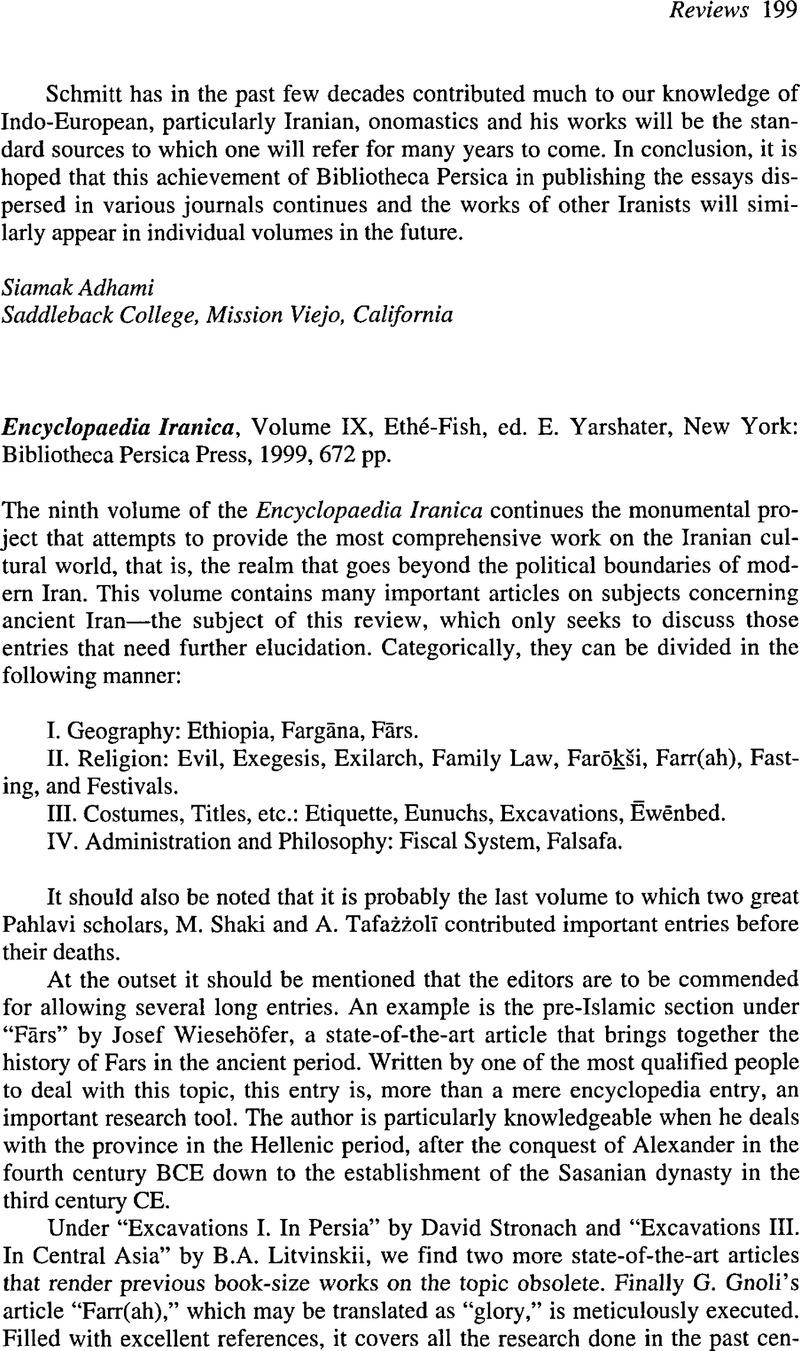No CrossRef data available.
Published online by Cambridge University Press: 01 January 2022

1. Šahrestānīhā-ī Ērānšahr, passage 33.
2. Altheim-Stiehl, R., “The Sasanians in Egypt: Some Evidence of Historical Interest,” Bulletin de la Société d'archéologie Copte, 31 (1992): 83ff.Google Scholar
3. Thomson, R.W., The History of Kings Vaxt'ang Gorgasali: Rewriting Caucasian History: The Medieval Armenian Adaptation of the Georgian Chronicles (Oxford, 1996), 211.Google Scholar
4. Qazvini, , “Muqaddimah-i qadīm-i shāhnāmeh,” Bīst maqālah-i Qazvīnī, (Tehran, 1332/1363): 2: 49.Google Scholar
5. Kūshnāmeh, ed. J. Matini (Tehran, 1378).
6. Mēnōg ī Xrad, VII, 10.
7. Shaki, M., “The Social Doctrine of Mazdak in the Light of Middle Persian Evidence,” Archív Orientální 46 (1978): 289–306.Google Scholar
8. For example see Shaked, Sh., “The Traditional Commentary on the Avesta (Zand): Translation, Interpretation, Distortion?” La Persia e l'Asia Centrale da Alessandro al x secolo, (Roma, 1996): 641–56.Google Scholar
9. Mazdapur, K., “Chāshtahā, sih nahlah-i fiqhī dar rūzgār-i Sāsānī,” in Yād-i Bahār (Tehran, 1376/1997): 389–412.Google Scholar
10. See Shāyist nē-shāyist, Chapter VI, 7.
11. Afnan, M., Zoroaster's influence on Greek thought (New York, 1965)Google Scholar and his Zoroaster's Influence on Anaxagoras, the Greek Tragedians, and Socrates (New York, 1969).Google Scholar
12. West, M. L., Early Greek Philosophy and the Orient (Oxford, 1971)Google Scholar, especially 88-89. For other discussions in relation to philosophical contact between Persia and Greece, see Duchesne-Guillemin, J., “D'Anaximandre à Empédocle: Contacts grécoiraniens,” La Persia e il Mondo Greco-Romano, (Rome, 1966): 423–32.Google Scholar
13. Gutas, D., “Paul the Persian on the Classification of the Parts of Aristotle's Philosophy: A Milestone between Alexandria and Baghdād,” Der Islam 60 (1983): 231–67.CrossRefGoogle Scholar
14. Duneau, J.-F., “Quelques aspects de la pénétration de l'hellénisme dans l'Empire perse sassanide (IVe-VIIe siècles),” Mélanges offerts à René Grozet, ed. Gallais, P. and Riou, Y.-J., (Poitiers, 1996), 1: 20.Google Scholar Also see Gutas, D., Greek Thought, Arabic Cultures, The Greco-Arabic Translation Movement in Baghdad and Early ᶜAbbāsid Society (2nd-4th/8th-10th centuries) (New York, 1998), 25–27.Google Scholar
15. Grignaschi, M., “La riforma tributaria di Hosroi e il feudalismo Sassanide,” La Persia nel medioevo, (Rome, 1971), 87–138Google Scholar; Rubin, Z., “The Reforms of Khusro Anūshirwān,” The Byzantine and Early Islamic Near East, State, Resources and Armies, ed. Cameron, A. (Princeton, 1995), 227–98Google Scholar; for land reforms and landholding see Morony, M., “Landholding in Seventh-Century Iraq: Late Sasanian and Early Islamic Patterns,” The Islamic Middle East, 700-1900: Studies in Economic and Social History, ed. Udovitch, A.L. (Princeton, 1981), 135–76Google Scholar; idem, “Land Use and Settlement Patterns in Late Sasanian and Early Islamic Iraq,” The Byzantine and Early Islamic Near East, Land Use and Settlement Patterns, ed. King, G.R.D. and Cameron, A. (Princeton, 1996), 221–29.Google Scholar